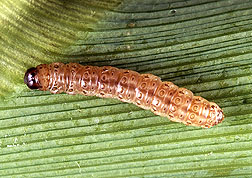This page has been archived and is being provided for reference purposes only. The page is no longer being updated, and therefore, links on the page may be invalid.
|
|
Borer Thwarted by Its Appetite and a FungusBy Dawn Lyons-JohnsonNovember 10, 1997 A hungry European corn borer larva may meet its match if it crawls onto a corn plant occupied by a common field fungus, Beauveria bassiana. Scientists at the Agricultural Research Service are using newfound knowledge of the harmonious relationship between the plants and the fungus to develop the fungus as a new natural control. Agronomists estimate corn borers cost growers millions of dollars annually and may cause yield losses up to 30 percent. Borer larvae burrow into cornstalks early in the season when corn plants are only a few inches tall. The pests feed on the plants, sapping their energy and nutrients. Feeding damage also contributes to lodging, or fallen stalks, when the plants mature and dry in the fall. The soil-dwelling fungus has long been known to be toxic to borers. But scientists at ARS’ Corn Insects and Crop Genetics Laboratory, Ames, Iowa, recently discovered that the fungus and corn plants can coexist without harming each other. The fungus lives and grows on the plant, and corn borer larvae that feed on the leaves become fungus food. Fungus spores attach to a larva, germinate, penetrate it and consume it. ARS entomologist Leslie C. Lewis and colleagues are conducting studies under a cooperative research and development agreement with Mycogen Seeds, St. Paul, Minn., and Mycotech Corp., Butte, Mont. In field trials, researchers saw 53 percent less borer damage on fungus-treated plants than on untreated controls. They applied Beauveria to leaves of young corn plants at the time of first flight of the adult corn borer moth. The moths seek mates during these flights, then lay their eggs on corn plants. But when larvae hatch and feed on a fungus-treated cornstalk, they ingest the fungus and die. An article about the research appears in the November issue of AgriculturalResearch, ARS’ monthly magazine. The article is also on the World Wide Web at: /is/AR/archive/nov97/fung1197.htm Scientific contact: Leslie C. Lewis, USDA-ARS Corn Insects and Crop Genetics Research Unit, Ames, IA 50011, phone (515) 294-8614, fax (515) 294-2265, Leslewis@iastate.edu |

